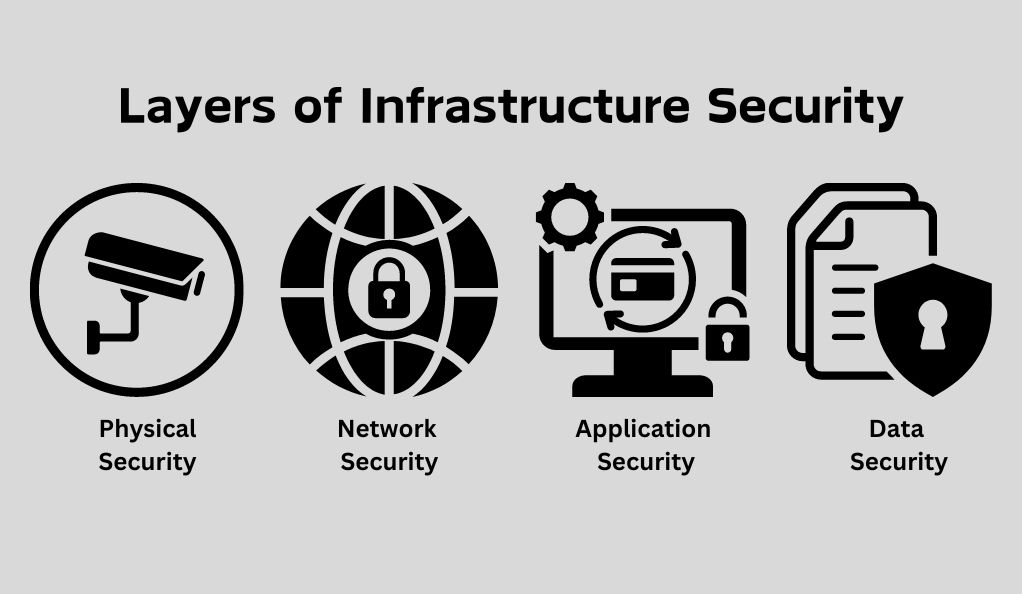Mastering Infrastructure Security: A Comprehensive Guide
Infrastructure security is vital in safeguarding both digital and physical assets. It involves protecting networks, data, and physical spaces from threats, ensuring operational continuity and data integrity in our increasingly digital world.
Evolution of Security Needs in a Digital Era
As we use more technology in our daily lives, the need to protect our digital spaces has grown. In the past, security might have meant just locking a door or a filing cabinet. Now, with so many activities happening online, we have to think about securing our digital information too. Hackers and cyber-attacks are real threats. They can steal data or disrupt operations. That’s why it’s crucial to have strong digital security measures. As technology evolves, so do the methods to protect it. We’re always finding new ways to keep our digital world as safe as our physical one. This evolution is a key part of infrastructure security in today’s digital era.
Definition and Importance
Infrastructure security is about keeping our important technology systems and physical places safe. It’s like having a strong lock on both your digital and real-world doors. In the digital world, this includes computers, networks, and data stored in the cloud. In the real world, it means securing buildings and physical assets. Why is this important? Because it keeps our operations running smoothly and protects valuable information from theft or damage. Without good security, businesses and organizations could face serious problems, like losing money or sensitive information.
Understanding the Layers of Infrastructure Security
Infrastructure security is like a multi-layered shield that protects both our digital and physical environments. Imagine it as a game where each level you pass adds more protection to your castle. In infrastructure security, each level focuses on a different area, from the doors and walls of our buildings to the data in our computers.

Physical Security: The Foundation of Protection
Physical security is the first line of defense. It’s like locking your doors and windows at home. This layer includes:
- Access Control: Using key cards or codes to enter buildings.
- Surveillance: Cameras and security guards keep an eye on things.
- Disaster Recovery: Plans for how to get back on track after things like floods or fires.
Network Security: Guarding the Digital Perimete
Network security is all about protecting the paths that our data travels on. It’s like having a guard who checks the IDs of everyone who wants to enter your digital world. This layer includes:
- Firewalls: They act as barriers, only letting safe data through.
- VPNs: Virtual Private Networks create secure connections, like private tunnels for data.
- Network Monitoring: Constantly watching the network to spot and stop problems.
Application Security: Safeguarding Software Assets
This is about keeping the software we use safe. It’s like making sure all the tools in your shed are in good condition and secure. This includes:
- Regular Updates: Updating software to fix any weaknesses.
- Protection Against Hacks: Using special software to stop hackers from breaking in.
Data Security: Protecting Core Business Assets
Data security means keeping the information stored on our computers safe. It’s like having a safe for your most valuable items. This includes:
- Encryption: Scrambling data so only people with the key can read it.
- Endpoint Security: Making sure all devices like laptops and phones are secure.
The Role of Cloud and IoT in Infrastructure Security
In today’s world, two big tech trends – Cloud Computing and the Internet of Things (IoT) – play a huge part in infrastructure security. Think of Cloud and IoT like new members in our security team, each bringing unique strengths and challenges.
Securing Cloud Environments: Shared Responsibility Model
Cloud computing is akin to leasing a storage unit instead of constructing your storage shed. While entrusting some security aspects to a provider, shared responsibility is key. The provider safeguards the infrastructure, covering physical servers and the network. Your responsibility is to safeguard your data by managing access and sharing permissions.
IoT Security Challenges and Solutions
IoT devices – like smart thermostats, watches, and fridges – are like tiny doors into our network. They can be handy, but each one can also be a way in for hackers. Securing IoT involves:
- Strong Passwords: Just like locking your front door, each device needs a strong, unique password.
- Regular Updates: Keeping the software on these devices updated to fix any security gaps.
- Network Segmentation: This is like having different rooms in a house; if a hacker gets into one device, they can’t easily access everything else.
Emerging Threats and Vulnerabilities
In the world of infrastructure security, new challenges and threats are always popping up. It’s like a game where the rules keep changing, and we need to stay alert to stay ahead. These threats can come in many forms and can impact both our digital and physical worlds.
Understanding and Mitigating Cyber Threats

Cyber threats are sneaky attacks that happen in our digital space. They are like invisible thieves trying to break into our online home. Here are some common ones:
- Phishing: This is when hackers trick you into giving them your passwords or other private info. It’s like a fake phone call asking for your credit card details.
- Ransomware Attacks: This is when hackers lock your files and ask for money to unlock them. It’s like someone stealing your diary and asking for cash to give it back.
- Botnets: These are networks of infected computers that hackers use to attack others. It’s like having a bunch of robots being controlled by a villain.
Physical Security Threats and Environmental Risks
Physical threats are dangers that can happen in the real world, affecting our buildings and equipment. These can include:
- Natural Disasters: Like floods or earthquakes that can damage our physical infrastructure.
- Theft and Vandalism: This is when someone physically breaks in and steals or damages our stuff.
- Utility Outages: Things like power cuts or internet outages that can disrupt our operations.
Best Practices in Infrastructure Security
In the world of infrastructure security, there are certain best practices or smart habits that help keep our digital and physical spaces safe. Think of these practices like the rules of the road when driving; they keep everything running smoothly and safely.
Implementing a Zero-Trust Approach
The zero-trust approach is like not letting anyone into your house unless you know them well. It means not automatically trusting anyone inside or outside the organization. Here’s how to apply it:
- Verify Everyone: Always check who is trying to access your network, like a doorman checking IDs.
- Limit Access: Give people access only to the information they need, like only letting guests into the living room, not the whole house.
- Keep Monitoring: Always watch for unusual activity, like a security camera in your home.
Continuous Monitoring and Incident Response
Constant vigilance is key in infrastructure security. It’s like having a guard always on duty, watching for any trouble.

- Regular Checks: Keep an eye on your networks and systems all the time, just like checking your doors and windows before going to bed.
- Quick Response: Have a plan to act fast if something goes wrong, like knowing what to do if you smell smoke in your house.
Employee Training and Awareness Programs
Teaching your team about security is super important. It’s like teaching your family how to stay safe in the house.
- Regular Training: Hold training sessions to teach your team about the latest security threats and how to avoid them.
- Create Awareness: Keep everyone updated about new security practices and encourage them to be alert.
Advanced Security Measures for Enhanced Protection
To keep our digital and physical spaces super safe, we sometimes need to use more advanced or high-tech methods. It’s like having some special gadgets in our security toolkit that help us stay one step ahead of threats.
Behavioral Analytics and AI in Security
Using behavioral analytics and Artificial Intelligence (AI) in security is like having a super-smart guard who can spot trouble before it happens. These tools can:
- Detect Unusual Behavior: AI can learn what normal activity looks like and then flag anything odd, like a security dog that barks when a stranger comes close.
- Predict Future Threats: These systems can also predict where attacks might come from next, like a weather forecast that warns us about a storm.
Next-Generation Firewalls and Threat Intelligence
Next-generation firewalls and threat intelligence are like having an advanced security system for your home.
- Smarter Firewalls: These are not just simple barriers; they are smart enough to check what’s passing through and make decisions, like a guard who knows who to let in and who to keep out.
- Threat Intelligence: This is like having up-to-date information on the types of criminals or attacks you might face, so you can be prepared, similar to a neighborhood watch that keeps everyone informed about local issues.
The Future of Infrastructure Security
As we look ahead, the future of infrastructure security is shaping up to be an exciting and challenging journey. It’s like looking into a crystal ball to see how we can better protect our digital and physical worlds. With rapid technological advances, our approach to security is constantly evolving.
Predictive Analytics and Machine Learning
In the future, we expect to see more use of predictive analytics and machine learning. This is like having a smart system that can not only tell you what’s happening now but also what might happen in the future. These technologies can:
- Spot Patterns: By analyzing past data, these tools can spot patterns that might hint at future security threats, like a detective solving a puzzle by looking at clues from past cases.
- Automate Responses: They can automatically respond to certain types of threats, making our security faster and more efficient, like having a robot guard that reacts instantly to danger.
Integrating Security in Business Strategy
Security will become an even bigger part of how businesses plan for the future. It’s like making sure the foundations of a house are strong before you start decorating.
- Part of Every Decision: Companies will think about security in every decision they make, like a chef who always considers food safety when cooking.
- Collaboration Across Departments: Different parts of a company will work together on security, like a team playing a sport where everyone has a role in defense.
Conclusion
In this journey through the world of infrastructure security, we’ve seen how important it is to keep both our digital and physical spaces safe. Like a captain steering a ship through stormy seas, we need to be alert, prepared, and equipped with the right tools and knowledge. From the basics of physical and network security to the advanced techniques using AI and predictive analytics, every aspect plays a crucial role.
Remember, good security is not just about reacting to threats; it’s about being proactive and always staying one step ahead. As we look to the future, let’s embrace the new technologies and strategies that will help us safeguard our valuable digital and physical assets. By working together, staying informed, and continually adapting, we can create a safer, more secure environment for everyone. Let’s keep building those strong walls of protection and keep a watchful eye on the horizon for new challenges and solutions.


Leave a Reply